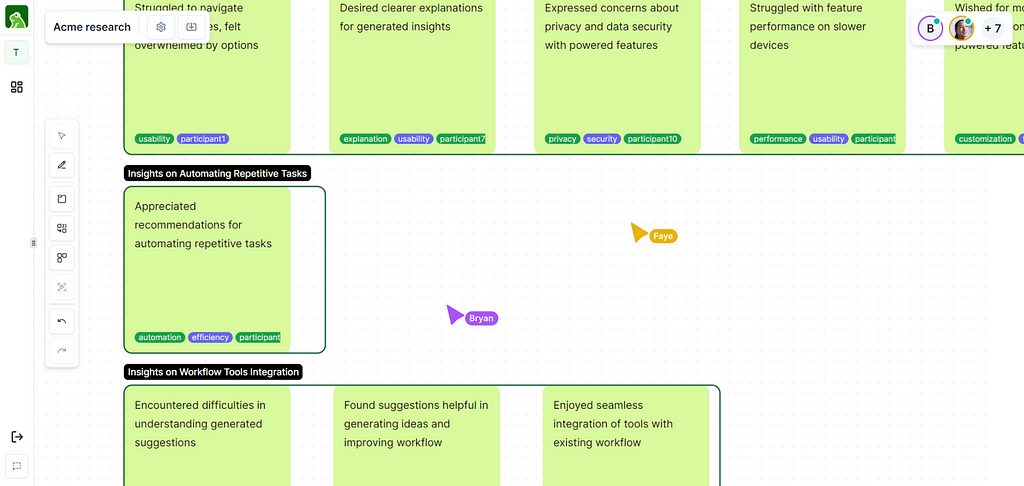User research stands as the cornerstone for product managers and design agencies striving to create impactful solutions. However, as the world and its problem become bigger, understanding user needs brings significant challenges for researchers. Synthesizing and comprehending user interviews, especially within the constraints of team dynamics and client expectations, can often feel like navigating a labyrinth. In this article I’ll explore how collaboration, coupled with new technology, can help to reshape the UX research process to develop robust research.
Collaboration isn’t just a buzzword — it’s the lifeblood of building understanding in user research. By bringing together diverse perspectives, opinions and skill sets, collaboration fosters creativity and opens doors to new insights.
But growing demand and expectations from clients make it hard to find that creative freedom that we so desperately need in our research. As project sizes become increasingly big and stakeholder involvement can be a lot, our traditional methods fail.
As a user researcher I find that we are increasingly moving towards a world of pace above quality. While I understand that things need to move quickly, it feels like anything research related needs to be finished yesterday — even though they told you today.
Personally I find it hard to contrast that with the academic design landscape. In the academic world you are allowed the freedom to explore and deliver when the quality is right, rather than when the time is up.
This ‘pens down’ pressure mixes bad with user problems that are becoming more and more complex (as we are designing more complex systems). As we start to increase
Managing large teams and accommodating client expectations becomes exponentially challenging, often leading to fragmentation and inefficiencies or worse — missed insights. It’s a shame to leave research’s gold nuggets just because it is too difficult to understand.
I do think there is a light at the end of the tunnel. With new tech’s (AI & ML) computational prowess, researchers can synthesize vast amounts of data beyond human capacity, uncovering patterns and trends that might otherwise go unnoticed. However, it’s essential to recognize that AI lacks the human touch — empathy and intuition that are integral to understanding nuanced user behavior. Instead, AI augments the research process, providing guidance and suggestive insights to complement human analysis.
My personal pursuit to scale research
In my personal pursuit to scale my own research practices I have met interviewed researchers from around the globe. It struck me that I am not the only one that struggles with scalability of our research practices. It is a limit of the design process. It may be due to time or scale, but the number of people we can interview will be limited.
As noted before, I firmly believe that AI can help us tackle the scalability issue. These tools can reshape the user research landscape, offering solutions to challenges and projects size previously too difficult to do. That’s why I’ve been working on building Leapfrog — a collaborative research tool designed to streamline our user research.
Picture this: You’re knee-deep in user interviews, surrounded by a mountain of data. It’s overwhelming, to say the least. But with Leapfrog, that mountain becomes a manageable hill. AI-enhanced whiteboards are more than just digital canvases — they’re collaborative hubs where insights come to life.
Imagine having a trusted colleague by your side, guiding you through the maze of data, pointing out patterns and trends you otherwise might have missed. This promises not a replacement scenario of AI, but rather an enhanced workflow for researchers to collaborate on.

Collaboration fosters creativity, encourages different perspectives, and ensures that insights are interpreted and applied effectively. By leveraging AI-driven tools (like Leapfrog) built a collaborative framework, researchers can harness the strengths of both technology and human intuition, driving innovation and delivering exceptional user experiences. With this holistic approach, research teams can navigate the complexities of user research with agility and precision, paving the way for meaningful outcomes and lasting impact.
Embracing New Tools for Research
As new technologies are seemingly coming out of every corner nowadays, it’s essential for researchers to embrace new tools and methodologies to stay ahead of the curve. The catch 22 lies in finding the right balance between human understanding of empathy and technological innovation.
By using smart collaborative tools to its advantage, research teams can unlock new insights, drive innovation, and ultimately deliver exceptional user experiences.
When it comes to creating a killer research thesis, collaboration is key. Both with new technology and your team mates. When we bring together different viewpoints and use smart tools, we can really nail our user interviews. User research can get tricky really fast. But by working together and using tech that boosts our skills, we can tackle those challenges head-on.
Resources
Leapfrog — A collaborative whiteboard for user research
Further reads
Understanding collaborative design — Research thesis on the topic of collaboration in design
Use design as a tool for better collaboration — Article by Design Council
A book on the use of AI in creative practices
The Power of Collaboration in User Research was originally published in UX Planet on Medium, where people are continuing the conversation by highlighting and responding to this story.